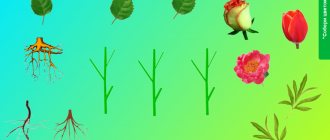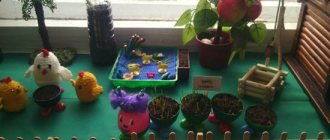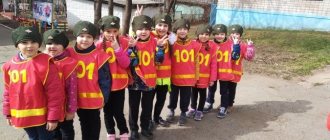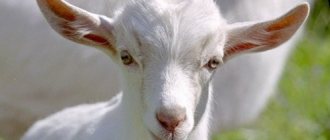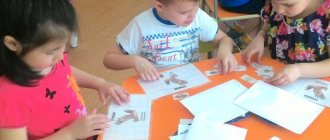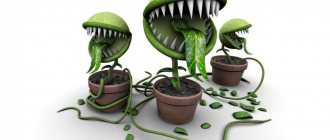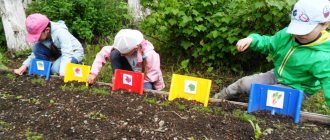Educational research project in the senior group. Green pharmacy
Educational and research project on ecology in kindergarten “Green Pharmacy”.
Senior group Type of project: By focus:
educational and information project
By number of participants:
group, subgroup.
By duration:
medium duration (1-2 weeks)
Project participants: • Children of the senior group • Educators • Parents Relevance “There is great power in herbs and words,” says an old Latin proverb. The properties of plants are wonderful and varied. The ability to love nature does not come on its own. The basis of children's conscious attitude towards nature should be knowledge about it, which is presented to children by adults in a vivid emotional form. And here a lot depends on the ability of an adult to teach children to recognize each plant and protect it. Observing and examining plants in the summer, on the street, in the meadow, in the garden, in the forest, the teacher’s task is to create conditions for introducing children to the world of medicinal plants of our region, to form ideas about the role of plants in the improvement and preservation of human health, therefore an ecological project "Green Pharmacy". Goal: To familiarize children with the most common medicinal plants of the Chelyabinsk region. Main objectives of the project: 1. Strengthen the ability to recognize and name medicinal plants (4-6 species). 2. Expand knowledge about the benefits and use of medicinal plants. 3. Introduce children to the rules of conduct when collecting medicinal plants. 4. To consolidate children’s knowledge about the structure, components, distinctive features of each type of plant, and use in food. 5. Develop skills: observe, compare, analyze and reflect on the results of observations in different types of creative activities (theatrical, gaming, musical, artistic, productive). 6. Enrich children's vocabulary and their knowledge about medicinal herbs. 7. Develop cognitive activity, thinking, imagination, communication skills, independence, hard work, observation and curiosity for all living things. 8. Foster a caring attitude towards nature, the natural heritage of our region, and involve in environmental activities. Expected result: During the implementation of this project, children will learn not only the names of medicinal plants and their appearance, but also their medicinal qualities.
Through research, they will become familiar with the properties of medicinal plants and the peculiarities of their vital functions. In the process of work, the development of cognitive processes, feelings of empathy, and communication skills will naturally occur, aimed not only at conflict-free communication between children and each other, but also at caring for nature in general. Download Educational and research project “Green Pharmacy”
We recommend watching:
Project in kindergarten for older preschoolers 5-7 years old on legal topics Project in the senior group of kindergarten Project in the senior group on the topic “Trees and shrubs in spring” Ecological and valeological project in kindergarten in the senior group
Similar articles:
Project for children of the senior group “Our cheerful garden”
"Green Pharmacy" on the kindergarten site
Yanina Bagaeva
"Green Pharmacy" on the kindergarten site
GREEN PHARMACY ON THE SITE OF OUR KINDERGARTEN.
Bagaeva Ya. V.
The importance of plants is incomparable. By teaching children to admire plants, to see and perceive their beauty, to take care of the beautiful creations of nature that decorate our cities and towns, by teaching them the ability to recognize the human doctor and his assistant in the simple grass that grows under their feet, makes it possible in the future to lead the child into science and medicine .
Children's specific knowledge about plants can only be formed on the basis of their sensory experience. Inhaling the aromas of medicinal plants in a green pharmacy , children learn about the world, learn to take care of vegetation, and preserve the beauty that green lawns .
The main goal of creating a green pharmacy on the territory of a kindergarten is the environmental education of children in preschool age. Often, due to lack of knowledge, children cannot choose the right course of behavior and we adults need to make educational work invisible and attractive to children, and that is why, with the help of a green pharmacy, made all activities in a playful and exciting way. Games and gaming elements give classes an emotional overtones, make them lively, allow children to develop a wide variety of positive qualities and facilitate the perception of knowledge. Successful work with children is possible only if the teacher uses a creative approach.
To create a green pharmacy, we allocated a plot of land on the territory of the kindergarten , prepared it and replanted medicinal plants, the area with a decorative net using pegs and left an entrance so that you could walk freely, placed signs with pictures of plants near each plant, laminated everything, also The doctor was made from plywood, painted over with oil paints and varnished so that nothing would get damaged in inclement weather.
In our green pharmacy we observed and examined medicinal plants (chamomile, mint, dandelion, plantain, rose hips, nettle, clover, burdock)
. Children learned that ordinary plants in the immediate environment can help human health, their importance in people’s lives, and their healing properties. They learned new terms: decoction, infusion, medicinal plants.
Children enjoyed writing descriptive stories on behalf of plants: “I am a daisy...”
,
“I am a nettle...”
,
“I am a plantain...”
We made up fairy tales, solved riddles, learned poems, played games ( “edible, inedible”
,
“identify by smell”
,
“tops-roots”
,
“find out the plant”
,
“what the plant heals”
,
“which part of the plant heals”
).
Literary works read:
1. Tamara Kryukova “Forest Pharmacy . Fabulous encyclopedia of medicinal plants"
2. A. Strizheva “Vegetable garden at the edge”
3. A. Onegova “Field path”
4. Yu. Dmitrieva “Who lives in the forest and what grows in the forest”
5. N. Pavlova “Riddles of flowers”
6. A. Pleshakova “ Green Pages ”
and etc.
Conducted a consultation with parents on the topic: “Medicinal plants for children”
The children learned that we are all part of nature and must treat it with care. That you need to grow medicinal plants in your plots and gardens , that you cannot harm nature, then it will appear before people as kind, giving its wealth and the joy of communication. Nature generously gives all its treasures to people and for everything asks only one thing: to take care of it!
We got acquainted with the rules for collecting medicinal plants:
1. It is good to know medicinal plants and distinguish them from poisonous plants.
2. It is better to collect plants in dry weather, in the morning after the dew has dried.
3. You cannot collect plants near the road; such plants are poisoned by poisons from vehicle exhaust pipes.
4. Place the picked plants in a wide basket so as not to crush them, otherwise the juice will be released.
5. Plants should be dried in the shade, not in the sun.
6. When collecting, you cannot trample on neighboring plants, you cannot tear plants by the roots and tear every last one.
7. Do not pick plants that are listed in the Red Book.
And of course, at the final stage we played “ Pharmacy ”
.
To buy any medicinal plant, you need to say the name of the plant, describe it, tell what you are going to be treated for. “
pharmacist ” must guess it,
the “buyer”
must not only describe it correctly, but also be polite.
"Green Pharmacy" Ds 223 - presentation
Pedagogical project “Let's get to know each other.... "Green Pharmacy" Developed by: teachers of MBDOU “Kindergarten 223” Skobeleva O.V., Vlasova I.V. Barnaul 2013
Summer is warm, Summer is red! The sun is good, the sun is clear! It's full of juice - the grass is green, collect it, dry it, it's time! And you collect grass... And store it for the winter! She will protect you from illness, she will give you health, strength in full!
Relevance The problem of environmental education has recently become especially important and has not been sufficiently worked out. The aggravation of the environmental problem in the country dictates the need for intensive educational activities designed to develop environmental consciousness and a culture of environmental management among the population, regardless of age and profession. This work must begin in kindergarten - the first link in the lifelong education system. Preschool childhood is the initial stage of the formation of a person’s personality, therefore, from this age it is necessary to try to form in children a consciously correct, protective, gentle and responsible attitude towards natural resources. A preschool child can learn to protect, care for and protect only what surrounds him and arouses his interest, what he has grown with his own hands or with the help of adults. Guided by such important documents as the “Decree of the President of the Russian Federation on environmental protection and ensuring sustainable development”, the Russian Federation Law “On Environmental Protection”, the Law “On Education”: based on the educational program on which the kindergarten operates: “N. M Krylova “Kindergarten - House of Joy”, we have set ourselves the goal: to instill in children a careful attitude to growing and caring for a group of medicinal plants that grow in the Altai Territory, through familiarization with them. Preliminary work was the results of the initial diagnosis of children 4-5 years old, which showed that children know little about these plants. They have great difficulty in naming their names (single answers: chamomile and dandelion). Based on the above, a contradiction arises: between the need to familiarize preschoolers with a group of medicinal plants and the lack of possibility of their visual and informational study in nature.
By studying the medicinal plants of Altai, we also strive to instill pride in the area where we live. Since the Altai Territory is rightfully considered one of the most environmentally friendly places not only in Russia, but also in the world. There are eight sites on the UNESCO World Natural Heritage List in Russia. Five of them are located in Altai. More than 2,000 plant species grow in Altai. There are about 660 species of useful plants directly used by humans. The flora of Altai is unique - more than 100 plant species are found only in Altai and nowhere else in the world. These are endemics that arose here in the process of evolutionary development, most of which include particularly valuable medicinal plants, such as red brush. The group of medicinal plants is one of the largest. Widely used in official medicine are golden root, bergenia, valerian officinalis, Ural licorice, azure blue, peony, dandelion, knotweed, and safflower fern. The Red Book of Russia (1988) includes ten species of plants growing in the Altai region: Siberian candyk, Ludwig's iris, Zalessky feather grass, feather-leaved feather grass, feather feather grass, Altai onion, steppe peony, Altai gymnosperm, Altai stellophopsis. Medicinal plants are our “green gold” and must be handled wisely. Today, the reserves of many medicinal herbs and plants are rapidly declining, some of them are about to disappear completely. Every year, interest in medicinal plants increases, more and more of them are harvested, and the number of adherents of herbal treatment is steadily increasing. In this regard, some endangered medicinal plants have already been included in the Red Book. With a rational approach to collecting medicinal plants, their supplies will be renewed. We need to help nature maintain balance. To do this, you need to skillfully and carefully handle its riches, in particular, medicinal herbs. To do this, it is simply necessary to begin to instill a sense of respect for nature, for its gifts, to cultivate pride in the place where we live, already from preschool age.
Goal: To create conditions in the group and on the territory of the preschool educational institution for: Studying medicinal plants growing in the territory of Altai Forming an idea about medicinal herbs (their importance in people’s lives) Developing the ability to grow medicinal plants and care for them
This project is designed for children of senior preschool age and is aimed at solving the following tasks: To form in children concepts about medicinal plants (what they look like, where they grow, what are their medicinal properties). Develop the ability to recognize plants by description and appearance, and name them. Involve children in environmental activities through growing and caring for medicinal plants. To reinforce in children the idea that plants need light, moisture, and warmth to grow and live. To form ideas about the benefits of medicinal plants and their role in human life. Cultivate a sustainable interest, love and respect for plants.
Hypothesis: The process of forming ideas about medicinal plants, their benefits and meanings for people’s lives in preschool children in kindergarten will be more effective if: - the teacher realizes the importance of the process of forming ideas about medicinal herbs in children, reinforcing them in various types of activities - if children -preschoolers will learn how plants can help human health and will treat them more carefully. -The pedagogical process is carried out taking into account the age characteristics of children and is built on the basis of the leading activity of a given age period - play.
“Material and technical resources necessary to complete the project” 1. Scientific and methodological (selection of literature, books, paintings...). 2. Material and technical (camera, stands, dishes for experimentation, gardening tools, boxes for germinating seeds, “Calendar for monitoring the growth and development of plants”). 3. Experimental site (flower beds with medicinal plants on the group site, an ecological corner in the group room, a natural corner on the territory of the Green Pharmacy kindergarten with the image of Doctor Aibolit). The project is implemented in joint play activities: children, teachers, parents, as well as in the independent activities of each project participant. Organization of a subject-development environment in the group: in the corner of the book there are bright encyclopedias, albums with images of medicinal plants. in the games corner there are educational games about medicinal plants and herbs. Project idea: creating a small garden of medicinal herbs and plants of the Altai Territory on the territory of the kindergarten.
Stages of the project: 1. Organizational diagnostics selection of methodological literature, pictures development of conversations, entertainment, holidays, quizzes, physical education minutes, etc. thematic planning selection of objects for excursions selection of musical repertoire work with parents on interaction within the framework of the project on the territory of the kindergarten a small garden of medicinal herbs, and also make tables - signs with the names of plants that will be planted there in the future. 2. Project implementation. Planting, caring for plants; observation of growth with recording of “Observations” in the calendar 3. Generalization stage: Design of a homemade book “My Favorite Medicinal Plant” (together with parents) Issue of a WALL NEWSPAPER “This is what we have grown...” Design of the herbarium “Medicinal plants and herbs of Altai” Ecological quiz “Clever and clever - on herbs and plants” Conducting the results of the project. Determining the effectiveness of the project. Diagnostics of children on the topic “Medicinal plants”. Presentation for parents and teachers of preschool educational institutions (summarizing the experience gained).
Venue: MDOU "Kindergarten 223", Barnaul Dates: September - May Number of project participants: 2 teachers: Skobeleva O.V., Vlasova I.V.; narrow specialists of MBDOU; children aged 4-5 years, parents. Project type: long-term, educational.
Expected result: children’s knowledge about medicinal plants; children’s caring attitude towards plants that help human health. Assessment methods: observation, conversation, analysis of children's creative products. Children - before starting work on the project, we have a conversation about medicinal plants. The goal is to find out children’s understanding of medicinal plants and their relationship to them, to interest them in the problem. Criteria for assessing results 1. Children know and name medicinal plants: 0-2 plants low level 3-4 plants average level More than 5 – high level. 2. Know and understand the medicinal properties of medicinal plants: 0-2 plants low level 3-4 plants average level More than 5 – high level In Figures 1 and 2 we see how the implementation of our project influenced the change in the levels of indicators for the formation of environmental knowledge in children , which relate to the topic of our research
Fig.1Fig.2
MEDICINAL CHAMOMILE (Matricária recutíta) MEDICINAL CHAMOMILE (Matricária recutíta) is a herbaceous plant from the family Asteraceae, or Compositae, a species of the genus Chamomile. Synonyms: mother grass, morgun. There are herbs that treat more than one disease and have a beneficial effect on the entire body. Such herbs include chamomile. It is desirable to have it in every home, especially if there are small children or elderly people. Everything will be cured by a beautiful flower that sways on a shaggy stem. Chamomile will relieve pain, calm you down, and strengthen your strength. This is a herbaceous annual with straight bare stems cm high, alternate leaves, inflorescences (baskets) with a diameter of 1.5-2.5 cm, with a pleasant smell, reminiscent of the aroma of ripe apples. Medicinal chamomile is easy to grow in your own garden. Seeds can be sown at any time of the season. Chamomile blooms from May to October, during which time the flowers can be harvested several times. It is found on roadsides, vacant lots, vegetable gardens, orchards, fields and other places.
Medicinal yarrow (common, Achillea millefolium. Other names: medicinal yarrow, bloody herb, tenacious herb, tree, gulavitsa, cut-grass, akhaley, soldier's grass, tree zvichayny, zelenets, serpiy, etc. This is one of the species of the genus yarrow, family Asteraceae (asteraceae). There are about 100 species in total: meadowsweet yarrow, musk yarrow, noble yarrow, felt yarrow, etc. For medicinal purposes, medicinal yarrow (common, Achillea millefolium) is used. Yarrow grass is a perennial herbaceous plant with a straight, ribbed, unbranched, sparsely hairy stem. Leaves alternately arranged, short-petioled, consisting of pointed leaves. At the top of the stem there is a dense corymbose inflorescence, which consists of small flower baskets. The baskets (flowers) have a specific, very pungent aroma. Yarrow is not a whimsical plant, grows in mixed forests, in clearings, in cutting areas, meadows, etc. For medicinal purposes, the tops of flowering plants with a stem (no longer than 15 cm) and flowers cut at a distance of 2 cm from the top are used. The raw materials are dried in the shade and stored for up to 2 years. Yarrow is used in medicine as a hemostatic agent, for internal and external bleeding, diseases of the gastrointestinal tract, for inflammatory processes, and also as an anticonvulsant, diaphoretic, appetizing agent, eliminating metabolic disorders. The leaves and flower baskets of yarrow contain a lot of essential oil, vitamin K, tannins, carotene, vitamin C and phytoncides. Yarrow is very popular in traditional and folk medicine; it is used to treat many diseases.
Great plantain (plantago major L.) Great plantain (plantago major L.) is an ancient medicinal plant. About two hundred and fifty species of plantain are known. They are found in subtropical and temperate zones (rarely found in the tropics). Plantain is found near the road, in vacant lots, near housing, in green meadows, vegetable gardens, orchards, along forest edges and the banks of reservoirs. A perennial herbaceous medicinal plant, 10 to 40 cm high with flower shoots and a rosette of wide-oval, green leaves. The flower arrow is bare and ends in a long spike of small flowers. Plantain leaves collected during flowering and seeds have medicinal properties. Plantain blooms from June to September. Fresh leaves have hemostatic, bactericidal, wound healing, hypotensive and expectorant effects. Juice of fresh leaves and water infusion of leaves are especially effective in treating stomach and intestinal ulcers, dysentery and dyspepsia, colitis, diseases of the bladder, upper respiratory tract, bronchi and lungs. It is better to collect and prepare leaves in meadows. Do not collect dusty leaves on the roadsides; instead of benefiting you, they will only bring you harm!

